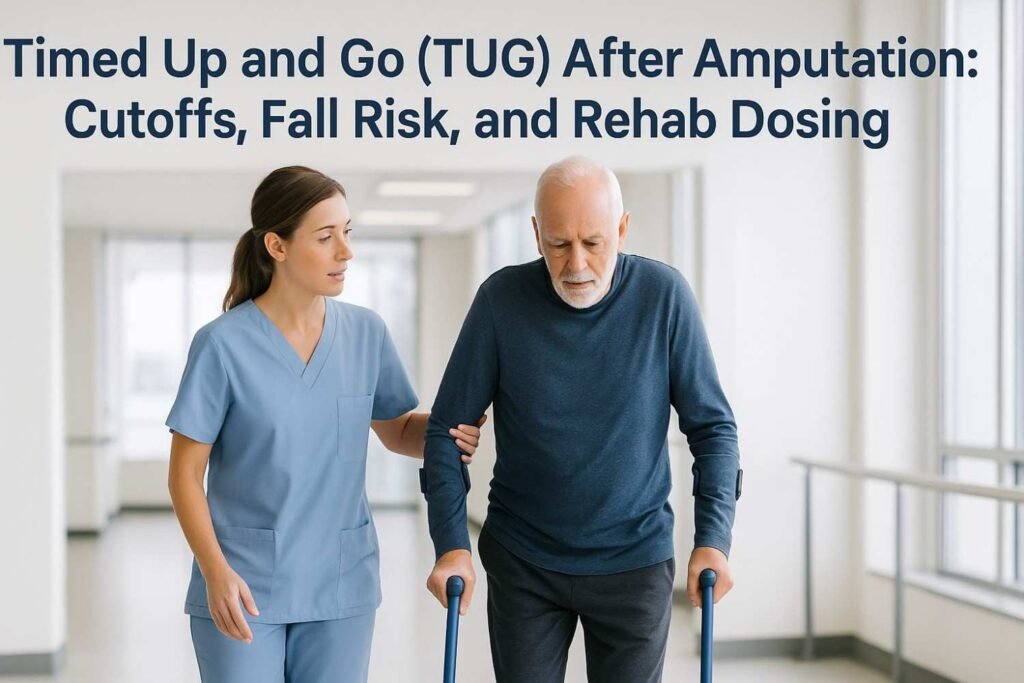The Timed Up and Go test is one of the quickest ways to understand how safely and confidently a person moves after an amputation. It takes less than a minute, but it reveals so much about balance, speed, stability, and real-life independence. For clinicians, this small test can act like a window into the user’s everyday world. It shows how ready they are to walk in crowds, move around at home, or return to work without fear of falling.
For amputees, the test is more than a number on a stopwatch. It tells a story about trust — trust in their body, trust in their prosthetic limb, and trust in their own ability to move freely again. A shorter time often shows comfort and confidence. A longer time may show fear, pain, or the need for more support. No matter the score, the test helps you understand exactly what the user needs next.
This article explores how to use the TUG test with skill, care, and purpose. You will learn what the times mean, how to read the hidden signs behind the movements, and how to use the results to build better rehab plans, reduce fall risk, and help amputees feel truly safe on their feet again.
Understanding the Purpose of the TUG Test After Amputation
Why the TUG Test Matters
The Timed Up and Go test is one of the clearest ways to see how safely a user can move in daily life.
It captures the full cycle of real movement: standing up, walking forward, turning, and sitting down again.
Each part of this cycle reveals something important about balance, joint control, and confidence.
For amputees, these movements can feel uncertain.
Standing up may be slow because the socket feels tight or painful.
Walking forward may be hesitant if the user fears the prosthetic knee or foot will not respond as expected.
The TUG test shows how the user handles these challenges.
A smooth performance often means strong recovery.
A slow or shaky performance shows where help is needed.
This makes the TUG test a simple but powerful way to guide care.
How the TUG Reflects Real-World Safety
The steps in the test match everyday situations.
People stand up from chairs many times each day.
They turn around corners, walk short distances, and sit down again.
If the user struggles during these small movements, they may face even greater trouble at home or in public.
A high TUG time often means the user is at risk of falling during daily activities.
When you see how they manage the full sequence, you understand whether they are ready for independent living.
This real-world link is one of the reasons the TUG test remains a trusted measure in prosthetic care.
How the TUG Helps Track Healing
The test helps you follow the user’s progress as their strength, coordination, and balance improve.
Early on, the user may move slowly because every motion feels new.
But with training, confidence builds and timing improves.
Over weeks and months, even small changes show how their body is adapting to the prosthetic limb.
You can use these changes to decide whether the person is improving at a healthy pace or needs extra support.
TUG results create a clear timeline of progress.
This timeline becomes a strong motivator for the user and a useful guide for the clinician.
Preparing an Amputee for the TUG Test
Setting Expectations Before the Test
Before the test begins, the user should understand what to expect.
They need to know the test is short, simple, and not meant to push them beyond their limits.
A clear explanation helps reduce fear.
The user should feel calm, safe, and ready to move at a steady pace.
Let them know that you are not judging them.
You are simply observing their natural movement to help them walk safely in daily life.
When expectations are clear, the user performs with more confidence and less stress.
Ensuring a Safe Testing Space
The testing area should be quiet, open, and safe.
A stable chair with armrests gives the user confidence when standing up and sitting down.
The walkway should be straight and free from obstacles.
Good lighting helps reduce stress and prevents fear of tripping.
If the user knows the environment is safe, they move more naturally.
This gives you a more honest view of their true ability.
The environment shapes both performance and emotional comfort.
Checking Physical and Emotional Readiness
Before starting, ask how the user feels.
If they are tired, stressed, or in pain, the test may not show their true ability.
A quick check of the residual limb is helpful.
If the skin looks irritated or the socket feels uncomfortable, performance may drop.
Emotional readiness matters as much as physical readiness.
If the user feels nervous, they may move slowly or hesitate too much.
A calm user gives a clearer, more accurate TUG score.
Looking at Prosthetic Fit and Stability
The prosthetic limb must feel secure before the test begins.
If the foot or knee feels unstable, the user may walk cautiously or avoid putting weight on the limb.
A quick fit check prevents unsafe movements.
If the socket fits poorly, you may see shifting, limping, or slow standing and sitting.
When the prosthetic components work smoothly, the user moves with ease.
A stable fit leads to more consistent and confident performance.
Conducting the TUG Test Step by Step
Standing Up From the Chair
The first movement shows strength and stability.
A smooth rise indicates good core and hip control.
If the user pushes heavily on the armrests, it may mean they lack leg strength or feel unsure about balance.
If they stand very slowly, it may show fear of falling.
Standing up is the first clue to how comfortable they feel with their prosthetic limb.
This moment sets the tone for the rest of the test.
Walking Forward
Once the user stands, they begin walking three meters forward.
This short walk reveals balance, pace, and step control.
If the steps are small or uneven, the user may feel discomfort in the socket.
If they walk too slowly, fear may be affecting their movement.
Walking forward also shows how well the prosthetic foot absorbs shock and returns energy.
A smoother walk often means the limb is supporting them well.
This part of the test mirrors everyday movement.
Turning Around
The turn is one of the most revealing movements in the test.
Users who feel unsteady often take wide or slow turns.
A quick, stable turn shows strong balance and knee control.
A shaky or hesitant turn shows fear or poor limb stability.
Turning requires trust in the prosthetic limb.
It shows whether the device supports controlled motion in all directions.
This part of the test often exposes hidden balance issues.
Walking Back to the Chair
The walk back shows how fatigue affects movement.
Some users start strong but slow down during the return.
A smooth return walk shows good endurance and confidence.
A slower return may show weakness, pain, or mental tiredness.
Watching the user closely during this part gives you clues about endurance.
Endurance is important for daily life, even in short distances.
The return walk is just as meaningful as the first walk.
Sitting Down
Sitting down safely is a major part of daily function.
A slow or cautious descent may show poor balance or fear of falling backward.
Some users “drop” into the chair because they cannot control the movement well.
This can show weak hip control or lack of confidence in the prosthetic limb.
A steady sit-down shows strong control and trust in their body.
This final step completes the cycle of functional movement.
Interpreting TUG Test Times After Amputation
What Shorter Times Usually Mean
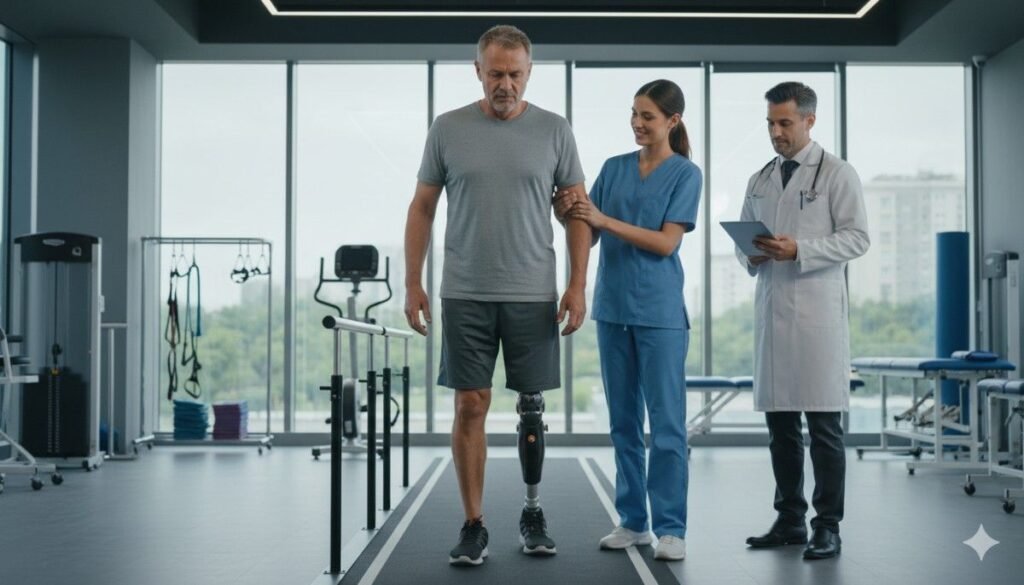
Shorter times often mean the user feels strong, balanced, and confident.
They can move through each step without hesitation or fear.
These users often have good socket comfort, strong core control, and smoother gait patterns.
They also tend to trust their prosthetic limb during turning and sitting.
Shorter times usually reflect readiness for more advanced training and greater independence.
These users may be ready for community walking or return-to-work planning.
A short time is not the only goal, but it is a strong sign of recovery.
What Longer Times Usually Mean
Longer times show that the user needs more support.
They may be dealing with pain, slow gait, or difficulty balancing.
Fear of falling often increases TUG time.
Hesitation during standing, turning, or sitting slows the overall performance.
Longer times help you identify where the user struggles most.
These areas become targets for therapy, training, or prosthetic adjustments.
A longer time is not a failure.
It is information that helps guide safer, smarter care.
Watching for Hidden Signs Behind the Time
The stopwatch shows one number, but the movement tells the real story.
A user may finish with a decent time but still show signs of imbalance or fear.
If they take too long to stand or turn, these moments may be more important than the overall score.
If they swing their leg or lean too much, it may show deeper gait issues.
The time is a summary, but your eyes tell the truth.
Your observations reveal how safe and confident the user truly is.
Understanding the small details makes the test far more meaningful.
TUG Cutoff Times and What They Mean for Amputees
Understanding General Cutoffs
TUG cutoffs help you understand whether the user is moving safely or at risk of falling.
While exact numbers vary between studies, the general idea stays the same: shorter times show better stability, while longer times show increased fall risk.
For amputees, the cutoffs need careful interpretation.
Their recovery path is different, their gait is different, and their daily challenges are unique.
A time around the lower end often means the user is ready for complex tasks.
A time closer to the higher end may mean the user needs more training or a prosthetic adjustment.
Cutoffs are guides, not labels.
They help you shape care without creating pressure.
Cutoffs for Transtibial Users
Transtibial users often reach faster TUG times because their gait stays closer to natural walking.
With good socket comfort and foot function, movement becomes smoother.
Their cutoff range is often shorter compared to other levels.
A lower time usually shows strong balance and good control of the residual limb.
If a transtibial user shows a high TUG time, it may signal pain, fatigue, or poor fit.
Even a small increase in time can reveal hidden issues.
These times help you identify when they are ready for higher-level mobility training.
Cutoffs for Transfemoral Users
Transfemoral users usually take longer on the TUG test because they must manage a prosthetic knee along with the foot.
The knee joint affects balance during standing, walking, and turning.
Their cutoff range is naturally higher.
A time that seems slow for a transtibial user may be perfectly expected for a transfemoral user.
Microprocessor knees often help reduce time because they create smoother, safer motion.
If a user is still struggling despite advanced components, training or alignment may need refinement.
Cutoffs for transfemoral users must always be read with context, not comparison.
Cutoffs for Bilateral Users
Bilateral amputees face additional challenges with balance, strength, and coordination.
Their TUG cutoffs are higher because every movement requires more effort.
Even if their time seems slow compared to other users, improvement over time matters far more.
Their performance must be judged against their own baseline.
A steady drop in TUG time for a bilateral user is a strong sign of progress.
Consistency is more meaningful than speed.
Cutoffs help guide safe movement and prevent falls.
Using the TUG to Detect Fall Risk
How Longer Times Predict Falls
A longer TUG time often shows that the user feels unsure during movement.
This hesitation increases fall risk during daily tasks like moving between rooms or walking outdoors.
If the user appears shaky or slow while turning, the risk is even higher.
Turning is often the most difficult and most dangerous part for amputees.
Longer times also reflect poor strength or weak balance.
These weaknesses make the user more likely to slip, trip, or misjudge steps.
The test becomes a quick way to spot danger before it leads to injury.
Key Movement Patterns Linked to Falls
Movement patterns often reveal fall risk even when the time is acceptable.
If the user leans heavily to one side, they may rely too much on the sound limb.
If they take short, cautious steps, they may fear the prosthetic limb will not support them.
Fear affects balance and increases fall risk.
A wide turn or slow spin often shows difficulty maintaining control.
These signs guide you toward balance training and gait correction.
Watching how the user moves is as important as watching the clock.
Emotional Signs That Predict Falls
Fear is one of the biggest predictors of falls.
A user who looks tense, anxious, or uncertain is more likely to move in unsafe ways.
Emotional hesitation shows up in slow sit-to-stand transitions or cautious stepping.
This fear creates stiffness, and stiffness increases fall risk.
By addressing emotional barriers, you help the user move more naturally.
A calm user is a safer user.
The TUG test brings these emotional clues into clear view.
How TUG Helps You Prevent Falls Early
If the user’s time increases over several visits, it signals a growing safety risk.
This early warning helps you adjust training, alignment, or prosthetic components before a fall occurs.
Reducing fall risk is not only about speed.
It is about helping the user feel safe, secure, and confident in each step.
The TUG test becomes a tool for protection as well as evaluation.
Using TUG Results to Guide Rehab Dosing
Deciding How Much Therapy Is Needed
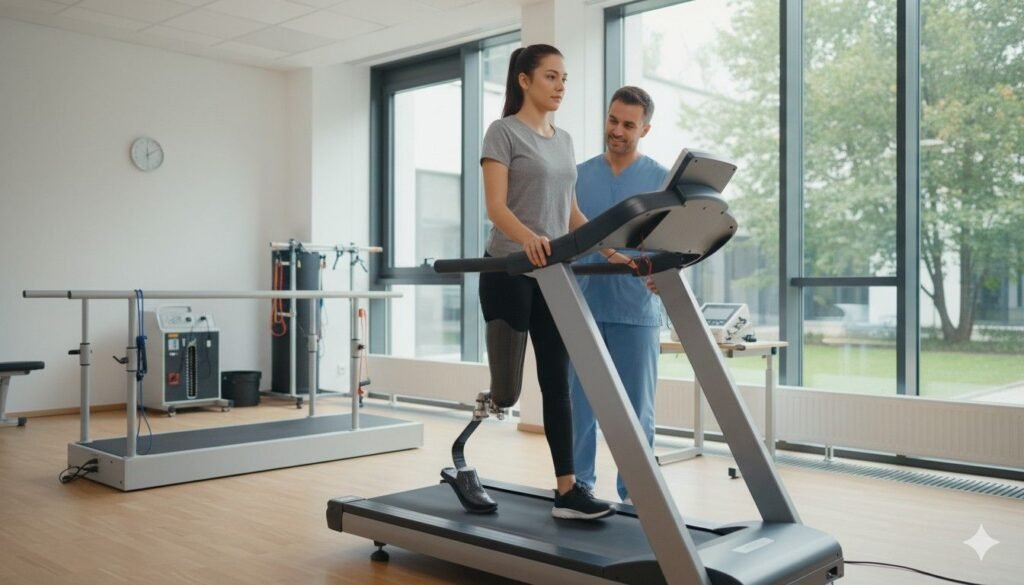
The TUG score shows how frequently the user may need therapy.
Higher times often mean they need more intensive sessions to improve strength and confidence.
Lower times may show that they are ready to move toward independent home exercises.
This progression helps you tailor the rehab plan with precision.
Rehab dosing is not about pushing harder.
It is about matching support to the user’s specific needs.
The TUG score gives you a clear starting point.
Matching Exercises to TUG Weaknesses
The way the user performs each part of the test shows exactly which muscles or skills need work.
If standing up takes too long, hip or core strength may be lacking.
If walking appears unstable, balance and gait training become the focus.
If turning is slow, coordination and knee control need practice.
These clues help you design exercises that target the user’s real challenges.
This targeted approach leads to faster improvements.
Rehab becomes smarter, not harder.
Adjusting Frequency as Times Improve
As TUG times improve, you can slowly reduce therapy frequency.
This supports independence without losing progress.
If progress slows, you can increase frequency again to push through the plateau.
This flexible approach keeps the user motivated and safe.
TUG times help you shape the long-term path of rehabilitation.
They give you the data you need to make confident decisions.
Using TUG Data for Home Exercise Planning
The test reveals what the user needs to practice at home.
If their sit-to-stand is slow, chair exercises may help.
If they feel unsure during turning, practicing gentle turns at home builds confidence.
If they tire quickly, short daily walks can improve endurance.
Home exercises extend the benefits of clinic sessions.
The TUG test gives you the blueprint for these exercises.
Emotional and Psychological Insights From TUG Performance
Reading the User’s Comfort Level
Facial expressions, breathing patterns, and body language reveal how comfortable the user feels.
A relaxed face shows trust in their prosthetic limb.
A tense face shows fear or doubt.
Even if the time is short, emotional discomfort affects long-term independence.
Understanding their feelings helps you support them in deeper ways.
Comfort is key to sustainable mobility.
Noticing Signs of Fear
Fear often appears in slow, careful movements.
A user who is afraid may take smaller steps or grip the chair tightly.
Fear slows down recovery and increases fall risk.
When you see fear, you know the user needs reassurance and gentle progressions.
The TUG test reveals these fears in a safe environment.
This helps you address them early.
Encouraging Positive Mindset Through Progress
Showing the user their improvement builds confidence.
Even a small reduction in time can lift their mood.
Celebrating these wins helps them feel proud of their progress.
This emotional boost increases their engagement in training.
A positive mindset supports stronger performance and deeper healing.
Building Trust Through Repetition
Repeating the TUG test helps the user become familiar with the movement.
With familiarity comes comfort and confidence.
Each repetition reduces fear and boosts control.
The test becomes a moment of growth rather than stress.
This trust carries into daily life as well.
Using the TUG to Adjust Prosthetic Components
Identifying When the Socket Needs Improvement
If the user hesitates during standing or shows uneven steps, socket fit may be the issue.
A poorly fitting socket disrupts every stage of the TUG.
Standing becomes slow.
Walking becomes uneven.
Turning becomes unsafe.
A better-fitting socket often leads to immediate improvement.
The test helps you spot these needs early.
Understanding Foot Performance
The prosthetic foot influences pace, step length, and stability.
If the user walks too slowly or appears unstable, they may need a different foot design.
Energy-return feet can improve rhythm and control.
A more flexible ankle component can support smoother turning.
The TUG test shows how well the foot supports real-life movement.
This helps guide upgrades.
Evaluating Knee Function for Transfemoral Users
The knee joint affects almost every part of the test.
If the user feels unsafe, they may lock the knee too often.
Locked knees slow down walking and turning.
This increases TUG time and reduces confidence.
Microprocessor knees often reduce hesitation and improve timing.
A noticeable drop in TUG time after switching knees confirms better support.
Checking Suspension for Stability
Suspension affects how secure the socket feels.
If the limb shifts during the test, the user may lose balance.
Good suspension leads to smoother standing, walking, and turning.
Poor suspension shows up as fear or slow movements.
The TUG test helps you decide whether a new suspension system is needed.
Using TUG Results for Long-Term Mobility Planning
Supporting Safe Community Walking
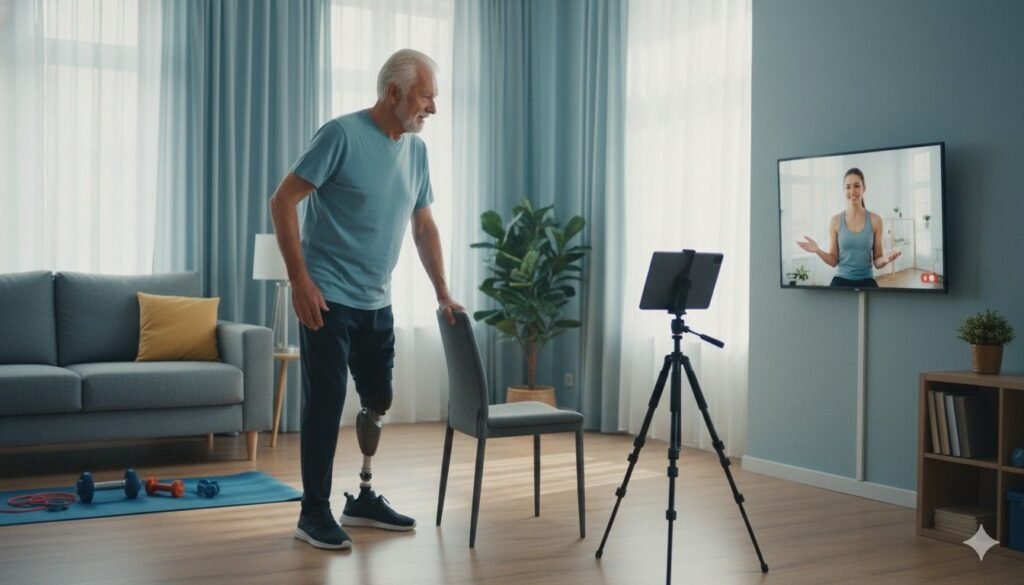
The TUG test helps you understand if the user is ready for outdoor walking.
Community walking requires quick adjustments, steady balance, and strong confidence.
If the user completes the TUG smoothly, they are closer to handling real-world challenges.
A shorter time often shows readiness for uneven paths, busy areas, or public transport.
A longer time shows that they may still struggle with sudden changes in surface or direction.
The test helps you choose the right training path to support safe community movement.
Planning Work and School Reintegration
Returning to work or school demands more than strength.
Users need to navigate chairs, move through hallways, and shift direction often.
The TUG test shows how well they handle these tasks.
If the user moves easily, they may be ready for longer days and more complex routines.
If they hesitate or move slowly, more preparation is needed before returning.
Using the TUG helps you create a plan that protects safety while supporting independence.
Understanding When Users Can Increase Activity
As TUG times improve, the user may feel ready for more physical activity.
Simple hobbies like gardening or walking with friends become easier.
A user with a strong TUG performance often has better endurance, balance, and control.
These signals guide you toward recommending more advanced exercises or recreational tasks.
The test helps you pace the user’s return to a full, active lifestyle.
Guiding Long-Term Exercise Routines
Long-term mobility requires consistent activity.
The TUG results help you choose the right exercises for daily practice.
If the user has trouble standing up, strengthening exercises help.
If turning is slow, balance drills are useful.
If walking is uneven, gait practice improves control.
The TUG test gives you long-term insight into what the user needs to maintain mobility for years.
TUG Variations and When to Use Them
Dual-Task TUG for Cognitive Load
Some users walk confidently when focused, but struggle when distracted.
Dual-task TUG adds a simple mental task, like counting, during movement.
If the user slows down too much, it shows they may struggle in busy or noisy places.
This insight helps you plan training for real-world environments.
Dual-task TUG provides a deeper look at safety in everyday life.
Fast-Pace TUG for Higher-Level Users
Users who move well during the standard TUG may benefit from a fast-paced version.
This variation shows how well they manage sudden changes in speed.
A smooth fast TUG means they can handle daily surprises like rushing across a street.
A slow or unsteady fast TUG shows they need more agility training.
This variation helps prepare users for advanced mobility challenges.
TUG With Obstacles
Adding small obstacles imitates common real-world barriers.
If the user struggles, they may not be ready for complex environments.
Obstacle-based TUG helps you plan training for stepping, avoiding objects, and adjusting speed.
It is especially helpful for users who live in busy or cluttered spaces.
Understanding TUG Declines and What They Mean
When Times Increase Suddenly
A sudden increase in TUG time is a clear warning sign.
It often means something in the user’s life or body has changed.
It may signal pain, limb volume change, socket problems, or fear after a near-fall.
Even emotional stress can slow movement.
By addressing these issues early, you protect the user from setbacks.
When Times Increase Slowly Over Months
A slow increase is also meaningful.
It may show that the user is losing strength or growing more cautious.
This gradual decline may connect to worn-out components or reduced activity at home.
It may signal the need for new exercises or upgraded prosthetic parts.
Tracking these small changes helps prevent bigger problems.
When Improvement Stops
A plateau in TUG times is common.
It shows the body has reached a temporary limit.
During a plateau, you can adjust strength training, change settings on the prosthetic, or introduce new challenges.
With the right support, the user usually begins progressing again.
Understanding plateaus helps keep the user motivated and steady.
When Users Report Increased Fear
If fear rises, TUG times often rise too.
Fear affects balance, speed, and every part of movement.
Listening to the user’s emotional concerns helps you guide them with care.
Sometimes reassurance and slow exposure to new tasks help more than physical training.
Fear is a powerful barrier, and TUG helps you see when it grows.
Using the TUG to Strengthen Clinical Decision-Making
Deciding When the User Is Ready for Independence
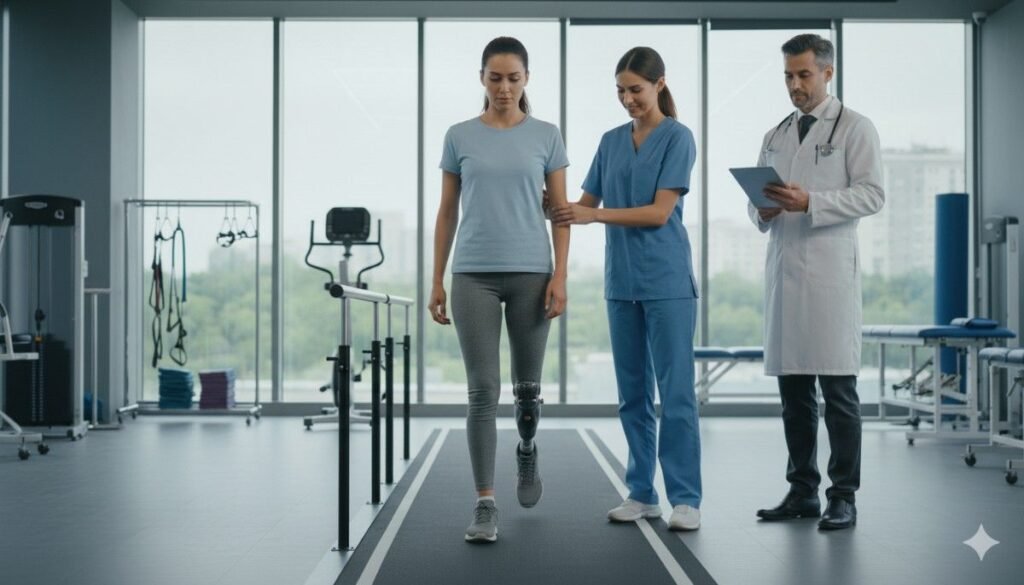
A smooth TUG performance shows readiness for more independent living.
The user can manage standing, turning, and sitting without losing balance.
This insight helps you decide when they can start doing more activities alone.
It also helps you determine when they are safe to navigate their home with minimal support.
Good TUG scores help build confidence for both the user and the clinician.
Choosing the Right Prosthetic Adjustments
If the user moves slowly or unevenly, prosthetic adjustments may be needed.
The TUG exposes issues in real movement that may not appear during short walks.
A better foot, a more stable knee, or a new socket design often improves timing.
When TUG time drops after an adjustment, you know you made the right call.
The test helps guide smart, evidence-based component decisions.
Supporting Insurance and Documentation Needs
Clear TUG results help clinicians justify the need for specific prosthetic components or therapy plans.
The test provides measurable evidence of function.
Strong documentation ensures the user gets the support and upgrades they need.
It also helps other professionals understand the user’s progress.
The TUG becomes a communication tool across the care team.
Tracking Long-Term Recovery Patterns
Over months and years, TUG patterns reveal how aging, health changes, and activity levels affect mobility.
This long-term view helps you adjust care with greater precision.
A stable TUG over years shows strong lifelong mobility.
A rising time shows the need for maintenance, new training, or component updates.
The test helps protect long-term safety and independence.
Differences in TUG Performance Among Amputation Levels
How Transtibial Users Typically Perform
Transtibial users often have smoother movements because the knee remains intact.
Their TUG times tend to be faster and more consistent.
If their times rise, it usually points to socket discomfort or a foot issue.
These users often respond quickly to targeted training.
Their performance helps guide return-to-work or higher-level mobility decisions.
How Transfemoral Users Typically Perform
Transfemoral users rely on strong hip control and knee confidence.
Their TUG times are naturally longer.
Fast improvements happen when they grow comfortable with the prosthetic knee.
If they rush or hesitate, it shows their knee settings may need adjustment.
Their performance gives you a clear picture of knee control and stability.
How Bilateral Users Typically Perform
Bilateral users often face greater balance challenges.
Their times may be longer, but even small improvements are meaningful.
Their TUG performance must always be read with compassion and context.
Each gain reflects strength and courage, not just physical ability.
Their movement tells a deeper story of adaptation and resilience.
Comparing Across Levels With Care
Comparisons between amputation levels are rarely helpful.
Each level has unique demands and patterns.
A transtibial time cannot be compared to a transfemoral time.
A bilateral user’s time cannot be compared to a unilateral user.
Progress should always be measured against the user’s own baseline.
Strengthening User Engagement Through TUG Testing
Helping Users See Their Progress

Showing users their improvement builds hope.
Even a one-second reduction matters deeply.
These small wins give them strength to continue therapy.
When they feel proud, they practice more consistently.
Progress becomes a shared celebration between clinician and user.
Reducing Anxiety About Movement
The more familiar the TUG becomes, the less fearful the user feels.
Repetition reduces stress and builds confidence.
A calm user moves more naturally and safely.
This change improves both timing and overall quality of movement.
Fear fades through understanding and experience.
Supporting Conversations About Independence
TUG results give you a simple way to discuss independence with the user.
You can show them what they are ready for and where they need support.
These conversations help build realistic goals.
They also encourage honest dialogue about fears and challenges.
The TUG becomes a bridge between hope and action.
Conclusion
The Timed Up and Go test may take only a few seconds, but it holds a clear and powerful picture of an amputee’s daily life.
It shows how well they stand, how steadily they walk, how safely they turn, and how confidently they sit.
It reveals their balance, their strength, and their fear.
It helps clinicians understand the user as a whole person — not just a limb, not just a number.
By reading the time, observing the movement, and listening to the emotions behind each step, clinicians can shape stronger rehab plans, reduce fall risk, and guide each person toward a safer and more independent life.
The TUG becomes more than a test.
It becomes a story of healing, courage, and human progress.
At Robobionics, we believe safe movement is a right, not a luxury.
We build advanced, affordable prosthetic limbs that help people move with dignity, confidence, and hope.
If you’d like to see how our solutions can support better outcomes and safer mobility in your practice, you can book a demo anytime through our website.
We’ll be honored to walk this journey with you — step by step, with care, compassion, and heart.



